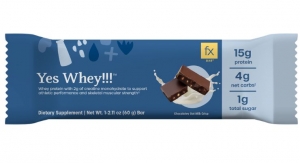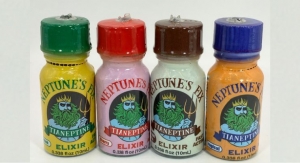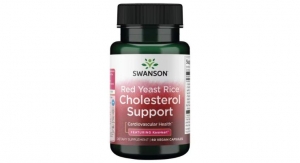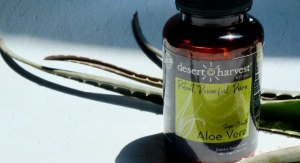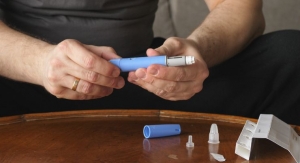07.07.23
Booth S3822
Newly-published research in the International Journal of Scientific Study found that Taiyo’s endosomal iron ingredient, branded as SunActive Fe, is better absorbed than conventional iron supplements. The study also revealed the ingredient’s unique metabolic pathway.
SunActive Fe’s patented delivery system creates endosomal iron pyrophosphate particles that disperse in water in a stable dispersion. The partice size is small enough to be directly absorbed by cells, via a process called endocytosis, which is a well-known absorption pathway of liposomes. SunActive Fe is useful for various applications, as it is stable against heat, salt, pH, and oxidation.
According to Taiyo, SunActive Fe does not cause stomach irritation nor have a metallic iron taste. Also, SunActive Fe will not stain teeth, cause black stools, constipation or other issues common with other iron supplements.
When consumed in the diet, water soluble iron and other soluble minerals are absorbed as metal2+-ions via the divalent metal ion transporter 1 (DMT-1) of the intestinal cells. Because this ion channel absorbs many minerals, they compete in their absorption through DMT-1, resulting in some nutrients not being absorbed efficiently. For example, the absorption of iron from a soluble iron source is inhibited by the calcium of milk when consumed together.
A preliminary in vitro study from 2017 originally demonstrated that SunActive Fe is absorbed via endocytosis through intestinal cells.
In this form of absorption, materials from a cell’s external environment engulf the cell membranes. It is a form of active transport that allows cells to internalize nutrients, signaling molecules, pathogens, and cellular debris. Other iron ingredients contain particles too large to be absorbed this way.
Study Details
The present study was performed in two different cell models Caco-2 and Raji-B-cells. Caco-2 cells can absorb iron via the DMT-1, and they also can perform endocytosis. In the Caco-2 cells SunActive® Iron was already better absorbed (27%) than 2 other iron pyrophosphate sources (13% and 16% respectively). The second part of the study used a two-cell culture model of combining Caco-2 cells with Raji-B cells. Raji-B cells are human B lymphocytes (B cells) that specifically perform endocytosis and are therefore able to absorb SunActive Fe particles directly.
The results show that SunActive Fe was around 2- 4 times better absorbed compared to other iron pyrophosphate products.
The model replicating just absorption via M cells found that SunActive Fe yielded 40% iron transport compared with the competitors’ 10.26% and 0.48%. “This nearly four-fold enhanced absorption via M cells compared to the nearest competitor shows the special properties that SunActive Fe possesses due to its patented technology,” observes Derek Timm, PhD, RDN, who serves as Taiyo’s functional ingredient technology expert.
A particle analysis of the three iron pyrophosphate sources showed that the average particle size of SunActive Fe was more than 50-100 times smaller than that of the other iron pyrophosphate sources, whose average particle size was around 20-40 µm. Such large particles cannot be absorbed by endocytosis. The large difference in the particle sizes of the three iron pyrophosphate sources seems to be the reason for the higher bioavailability of SunActive Fe versus other iron sources.
Because SunActive Fe is less reactive with food materials, it is suitable for functional foods, beverages, and supplements such as powdered drink formulas.
Newly-published research in the International Journal of Scientific Study found that Taiyo’s endosomal iron ingredient, branded as SunActive Fe, is better absorbed than conventional iron supplements. The study also revealed the ingredient’s unique metabolic pathway.
SunActive Fe’s patented delivery system creates endosomal iron pyrophosphate particles that disperse in water in a stable dispersion. The partice size is small enough to be directly absorbed by cells, via a process called endocytosis, which is a well-known absorption pathway of liposomes. SunActive Fe is useful for various applications, as it is stable against heat, salt, pH, and oxidation.
According to Taiyo, SunActive Fe does not cause stomach irritation nor have a metallic iron taste. Also, SunActive Fe will not stain teeth, cause black stools, constipation or other issues common with other iron supplements.
When consumed in the diet, water soluble iron and other soluble minerals are absorbed as metal2+-ions via the divalent metal ion transporter 1 (DMT-1) of the intestinal cells. Because this ion channel absorbs many minerals, they compete in their absorption through DMT-1, resulting in some nutrients not being absorbed efficiently. For example, the absorption of iron from a soluble iron source is inhibited by the calcium of milk when consumed together.
A preliminary in vitro study from 2017 originally demonstrated that SunActive Fe is absorbed via endocytosis through intestinal cells.
In this form of absorption, materials from a cell’s external environment engulf the cell membranes. It is a form of active transport that allows cells to internalize nutrients, signaling molecules, pathogens, and cellular debris. Other iron ingredients contain particles too large to be absorbed this way.
Study Details
The present study was performed in two different cell models Caco-2 and Raji-B-cells. Caco-2 cells can absorb iron via the DMT-1, and they also can perform endocytosis. In the Caco-2 cells SunActive® Iron was already better absorbed (27%) than 2 other iron pyrophosphate sources (13% and 16% respectively). The second part of the study used a two-cell culture model of combining Caco-2 cells with Raji-B cells. Raji-B cells are human B lymphocytes (B cells) that specifically perform endocytosis and are therefore able to absorb SunActive Fe particles directly.
The results show that SunActive Fe was around 2- 4 times better absorbed compared to other iron pyrophosphate products.
The model replicating just absorption via M cells found that SunActive Fe yielded 40% iron transport compared with the competitors’ 10.26% and 0.48%. “This nearly four-fold enhanced absorption via M cells compared to the nearest competitor shows the special properties that SunActive Fe possesses due to its patented technology,” observes Derek Timm, PhD, RDN, who serves as Taiyo’s functional ingredient technology expert.
A particle analysis of the three iron pyrophosphate sources showed that the average particle size of SunActive Fe was more than 50-100 times smaller than that of the other iron pyrophosphate sources, whose average particle size was around 20-40 µm. Such large particles cannot be absorbed by endocytosis. The large difference in the particle sizes of the three iron pyrophosphate sources seems to be the reason for the higher bioavailability of SunActive Fe versus other iron sources.
Because SunActive Fe is less reactive with food materials, it is suitable for functional foods, beverages, and supplements such as powdered drink formulas.



